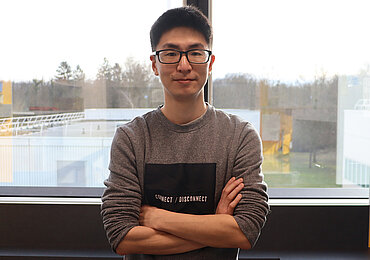New research team : Minchul Kim joins the IGBMC
Minchul Kim will join the IGBMC as team leader on 1 February 2022. His team, entitled "Syncytial Cell Biology", joins the Developmental Biology and Stem Cell Department. His research project focuses on syncytial cells, cells in which there are several nuclei in a single cytoplasm. Minchul decided to move to the IGBMC to develop his project further.

In 2007, Minchul began his research career at KAIST (Korean advanced institute of science and technology) in South Korea, with a thesis entitled "Characterization of the Hippo tumor signaling pathway in the mammalian system". After defending his PhD in 2013, he stayed at KAIST for another year as a post-doc and then went to work at Harvard medical school from 2015 to 2016, in a laboratory specialising in cancer research and epigenetics.
Wishing to move to a research topic with stronger physiological aspects, Minchul joined the Max Delbrueck Center for Molecular Medicine in Berlin from 2017. In this laboratory, he joined a team focusing on developmental biology, muscle and peripheral nervous system development. This period was crucial for his career as it was the moment when he "started to realise how unique the cells that make up muscle, and especially syncytial cells, are", he explains.
"Syncytial cells are cells that have multiple nuclei in a single shared cytoplasm, where normally the cells in our body have a single nucleus," Minchul explains. This category of cells includes, for example, some muscle cells, placenta cells or osteoclasts found in bones. "However, for me there are other criteria to consider for a cell to be considered syncytial," because other cells in our body can have multiple nuclei, such as some located in the liver or heart. For them to be considered syncytial, Minchul explains that "they must :
- result from a fusion of several mononuclear cells, not from DNA duplication without cytoplasmic division ;
- depend on having several nuclei for their biological functions to be performed, unlike others for which this may even be disadvantageous”.
On the subject of syncytial cells, Minchul plans to explore :
- how such diverse nuclear fates are established and maintained within the shared cytoplasm ;
- how additional mechanisms such as splicing or diffusion of biomolecules consolidate the identities of specific nuclei after the gene is being expressed from a specific part of the muscle ;
- the nuclear composition of muscle under various pathophysiological conditions and how newly emerging nuclei impact on muscle health.
Part of Minchul's team's research will focus on syncytial cells specific to skeletal muscle, which can be affected by many diseases, whether genetic in origin, such as Duchenne muscular dystrophy, or diabetes, or by processes such as aging. With this "unique approach, we could provide new strategies to treat muscle-related diseases or improve existing strategies by better understanding the composition and conditions of muscle health".
After obtaining ATIP-Avenir funding, Minchul was looking for the most suitable environment to support his research project. Needing access to mouse models as well as advanced sequencing expertise, he chose the IGBMC, which is a reference institute in these two fields.
Read more about Minchul Kim's recent work in this publication: https://www.nature.com/articles/s41467-020-20064-9
